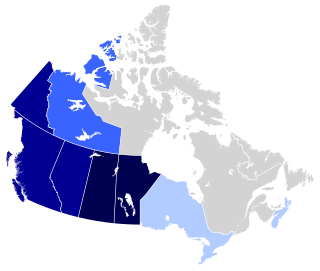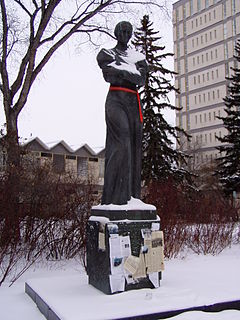Eaton Internment Camp, although short-lived, was one of twenty-four official internment facilities created in Canada to accommodate prisoners of war during the period from 1914 to 1920. It was the only facility of its kind in the province of Saskatchewan.
Under the 1914 War Measures Act , 8,579 enemy aliens — nationals of countries at war with Canada — were interned in Canada during World War I as prisoners of war. Primarily immigrant settlers of Ukrainian origin, they were sent to prisoner of war camps—most located in the Canadian hinterland—where they would work on government public projects as military conscript labour. Toward the end of the war however, the majority of internees were conditionally released to industry, the result of the growing labour shortage. This led to some camps being dismantled, others consolidated, as well as to the relocation of those internees considered undesirable.
As part of this relocation process, sixty-five internees were sent in October 1918 to an internment facility at Munson, Alberta where they laboured on the railway. However the outbreak of the 1918 flu pandemic (Spanish Influenza) and disciplinary issues forced the relocation of the Munson camp. On February 25, 1919, the internees were removed to a hastily constructed camp on the site of the railway siding at Eaton, Saskatchewan. It was thought that the move would placate the inmate population. It had little effect. Growing resistance among the internees and lack of confidence in the military guard prompted authorities to abandon the Eaton siding location for more secure facilities. On March 21, twenty-four days after the facility was initially established, the internees were transported by rail to a military installation at Amherst, Nova Scotia where they were to be processed for deportation. The Eaton Internment Camp was dismantled shortly afterwards.
The site of the original camp is on the grounds of the present-day Saskatchewan Railway Museum, situated at the junction of Highway 60 and the Canadian National Railway, four kilometers southwest of Saskatoon. In 2005, as part of a national campaign to seek official acknowledgement and redress for the World War I internment of Ukrainians and others, the Prairie Centre for the Study of Ukrainian Heritage, an academic unit at the University of Saskatchewan, in association with the Saskatchewan Railway Museum commissioned and unveiled on the original site a bronze and tindal-stone memorial. The monument entitled "Fortitude" was sculpted by Saskatchewan artist Grant McConnell.

During World War II, the United States forcibly relocated and incarcerated about 120,000 people of Japanese ancestry, most of whom lived on the Pacific Coast, in concentration camps in the western interior of the country. Approximately two-thirds of the internees were United States citizens. These actions were initiated by president Franklin D. Roosevelt via executive order shortly after Imperial Japan's attack on Pearl Harbor.
Garrison Petawawa is located in Petawawa, Ontario. It is operated as an army base by the Canadian Army.

Beginning in 1942, the internment of Japanese Canadians occurred when over 22,000 Japanese Canadians—comprising over 90% of the total Japanese Canadian population—from British Columbia were forcibly relocated and interned in the name of national security. The majority were Canadian citizens by birth. This decision followed the events of the Japanese invasions of British Hong Kong and Malaya, the attack on Pearl Harbor in Hawaii, and the subsequent Canadian declaration of war on Japan during World War II. This forced relocation subjected many Japanese Canadians to government-enforced curfews and interrogations, job and property losses, and forced repatriation to Japan.

Ukrainian Canadians are Canadian citizens of Ukrainian descent or Ukrainian-born people who immigrated to Canada. In 2016, there were an estimated 1,359,655 persons of full or partial Ukrainian origin residing in Canada, making them Canada's eleventh largest ethnic group and giving Canada the world's third-largest Ukrainian population behind Ukraine itself and Russia. Self-identified Ukrainians are the plurality in several rural areas of Western Canada. According to the 2011 census, of the 1,251,170 who identified as Ukrainian, only 144,260 could speak the Ukrainian language.

The Ukrainian Canadian internment was part of the confinement of "enemy aliens" in Canada during and for two years after the end of the First World War. It lasted from 1914 to 1920, under the terms of the War Measures Act.
Highway 60 is a provincial highway in the Canadian province of Saskatchewan. It runs from Highway 7 near Saskatoon to Pike Lake Provincial Park. The highway is approximately 23 km (14 mi) long. This route primarily serves as a link connecting Saskatonians to Pike Lake and its campground, though it is also an important local road for acreages and businesses in the area. The speed limit is 90 km/h (55 mph). The Saskatchewan Railway Museum is located at the Hawker Siding about 3 km from Highway 7. Hawker Siding was previously known as Eaton Siding. A Ukrainian church is farther south on the highway.

Munson is a village in central Alberta, Canada. It is located 13 km north of the Town of Drumheller along Highway 9 and the Canadian National Railway tracks.

The Topaz War Relocation Center, also known as the Central Utah Relocation Center (Topaz) and briefly as the Abraham Relocation Center, was an American concentration camp which housed Americans of Japanese descent and immigrants who had come to the United States from Japan, called Nikkei. President Franklin Roosevelt signed Executive Order 9066 in February 1942, ordering people of Japanese ancestry to be incarcerated in what were euphemistically called "relocation centers" like Topaz during World War II. Most of the people incarcerated at Topaz came from the Tanforan Assembly Center and previously lived in the San Francisco Bay Area. The camp was opened in September 1942 and closed in October 1945.
Fort Lincoln Internment Camp was a military post and internment camp located south of Bismarck, North Dakota, USA, on the east side of the Missouri River.

Internment of German resident aliens and German-American citizens occurred in the United States during the periods of World War I and World War II. During World War II, the legal basis for this detention was under Presidential Proclamation 2526, made by President Franklin Delano Roosevelt under the authority of the Alien Enemies Act.

The Association of United Ukrainian Canadians (AUUC) is a national cultural-educational non-profit organization established for Ukrainians in Canada. With branches throughout Canada it sponsors such cultural activities as dance groups, orchestras, choirs and children's activities, and is involved in social justice and solidarity activities in partnership with other ethnocultural organizations, peace groups, and community organizations.

Lubomyr Yaroslav Luciuk is a Canadian academic and author of books and articles in the field of political geography and Ukrainian history. He is currently a full professor at the Royal Military College of Canada.

Crystal City Internment Camp, located near Crystal City, Texas, was a place of confinement for people of Japanese, German, and Italian descent during World War II, and has been variously described as a detention facility or a concentration camp. The camp, which was originally designed to hold 3,500 people, opened in December 1943 and was officially closed on February 11, 1948.

The Castle Mountain Internment Camp, located in Banff National Park, Alberta, was the largest internment facility in the Canadian Rockies, housing several hundred prisoners at any one time. Established on July 13, 1915, a total of 660 enemy aliens were interned at the facility during its entire operation.
Frederick Langdon "Fred" Davis, was a lawyer and political figure in Manitoba, Canada. He represented Neepawa in the House of Commons of Canada as a Unionist member.
The Ukrainian Canadian Civil Liberties Association (UCCLA) is a Ukrainian nationalist organization in Canada. Established in 1986 after the Civil Liberties Commission was disbanded, its members – all of whom are volunteers – have been particularly active in championing the cause of recognition, restitution and reconciliation with respect to Canada's first national internment operations, helping secure a redress settlement in 2008 with the Government of Canada along with the Ukrainian Canadian Congress and the Taras Shevchenko Foundation. They have also downplayed the extent and crimes of Nazi war criminals hiding in Canada, and documented the presence of veterans of the NKVD, SMERSH, and KGB in Canada. The first chairman of the CLC/UCCLA was John B. Gregorovich, a lawyer. The current chairman is Roman Zakaluzny; the immediate past president was Professor Lubomyr Luciuk.

The Santa Fe riot was a confrontation at a Japanese internment camp near Santa Fe, New Mexico, during World War II. On March 12, 1945, approximately 275 internees assembled in Camp Santa Fe to watch and protest the removal of three men to another camp. During which, a scuffle broke out between the internees and the Border Patrol agents who were guarding the facility, resulting in the use of tear gas grenades, batons, and the serious injury of four internees.

The Lordsburg killings refers to the shooting of two elderly Japanese American men named Toshiro Kobata and Hirota Isomura at an internment camp outside Lordsburg, New Mexico, on July 27, 1942. The shooter, Private First Class Clarence Burleson, was charged with murder, but he was later acquitted after testifying that he was following military protocol.
Italian prisoners of war in Australia were Italian soldiers captured by the British and Allied Forces in World War II and taken to Australia.













